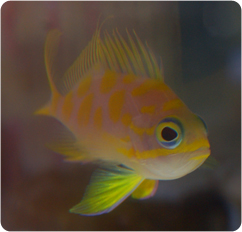|
Odontanthias borbonius - Yellow-Spotted Anthias
A Rare, Deepwater Anthias  The yellow-spotted anthias, also called the checked swallowtail and the Japanese spotted anthias, is a true gem of a marine aquarium fish. While not inexpensive, this small (to 15 cm or about 6 inches) fish is a real beauty to behold and, given the right environment and husbandry, it is not exceptionally difficult to keep. The yellow-spotted anthias, also called the checked swallowtail and the Japanese spotted anthias, is a true gem of a marine aquarium fish. While not inexpensive, this small (to 15 cm or about 6 inches) fish is a real beauty to behold and, given the right environment and husbandry, it is not exceptionally difficult to keep.
Previously listed under the genus Holanthias, the yellow-spotted anthias’ current valid scientific name is Odontanthias borbonius. This is a tropical and subtropical pelagic-oceanic species that frequents great depths (to 300 meters). While it can be found in the Indo-Pacific from South Africa to Palau to Indonesia, it is most commonly associated with the rocky reefs of subtropical Japan (hence the common name Japanese spotted anthias) where they are most commonly collected at depths of between 60 and 90 meters.
“These are a deep water anthias,” says Mark Martin, director of marine ornamental research at Blue Zoo Aquatics. “They are commonly found in Japan but also collected from northern Indonesia where they come up to as shallow as 60 meters seasonally. We tend to see more of them in the marine aquarium trade in North America in the spring, so getting them this early is a real bonus!”
In terms of care, the yellow-spotted anthias is like many other anthias species. The reason most anthias species are considered difficult to keep in a home aquarium is because they are very active fishes that are also extremely competitive. As such, anthias need to feed frequently. In the wild, anthias feed near-constantly on zooplankton, which is in abundant supply in the fishes’ natural habitat. In the aquarium, however, where populations of copepods, fish eggs, larva, and other zooplankton are limited, the aquarist must meet the fishes’ needs by feeding three or more times per day. This is a husbandry requirement that many casual aquarists are not prepared to meet.
In addition to the challenges of feeding anthias, most species are highly competitive fishes that can exhibit undue aggression in the captive environment. The reason for this is that all the common anthias species in the marine aquarium hobby are protogynous hermaphrodites which establish complex social rankings. The resulting pecking order, not to mention the aggression exhibited by individuals as they establish their place in the pecking order, can make keeping a shoal of anthias difficult unless the aquarist understands the behavior and plans accordingly.
In addition to their feeding requirements and innate aggressive tendencies, anthias are prone to both bacterial and protozoan infections. For this reason, it is absolutely essential to provide as stress-free an environment as possible for these fishes, as stress can trigger outbreaks of disease, infestations and infection.
Successful Anthias Husbandry
Anthias do best in a large aquarium with plenty of life rock. Because anthias require more feeding than many other species of marine aquarium fishes, it is generally advisable to provide hefty filtration including an excellent protein skimmer. Keeping the water quality high and stable will go a long way to reducing stress. Any aquarium housing anthias should be covered, as many species are known jumpers.
Anthias should only be housed with other peaceful community fishes. Generally considered reef compatible, anthias will leave all sessile invertebrates alone, although they may be harmed by larger invertebrates such as some anemones (e.g., carpet anemones (Stichodactyla spp.), corkscrew anemones (Macrodactyla doreensis)). As adults, this anthias species may also eat some invertebrates such as ornamental shrimp.
Perhaps the single most important thing the saltwater aquarist can do for his or her anthias is to provide them with a refugium. A refugium is essentially a refuge in the form of a separate tank plumbed to the display tank. The refugium houses organisms that might otherwise be consumed in a reef tank. Most importantly, a refugium can promote healthy populations of zooplankton that will then make their way into the display tank providing a source of food for the anthias. Designing, setting-up, stocking, and maintaining a refugium is beyond the scope of this article, but suffice it to say that the use of a refugium is a definite benefit in any system housing anthias.
Even without a refugium, many anthias can be successfully kept if provided a diet of small meaty foods at least three times per day. Frozen mysid shrimp are appreciated and should be offered. Most anthias will also readily accept commercially prepared foods.
|